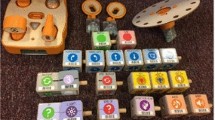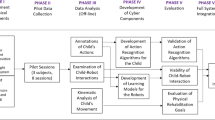Abstract
A study is presented to describe cognitive-developmental training involving use of connected boards elevated 3 to 6 feet above the ground together with special language signs. The subjects, 12 boys and 7 girls, were mute autistic children. Thirteen were in residential treatment and 6 attended day school. Signs were systematically paired with appropriate spoken words which all children learned to understand. Also, all learned to initiate signs to achieve desired objects or goals. The day school children, a younger group, achieved significantly greater expressive use of signs and words than residential school children. Two children, whose case histories are summarized, made the transition from signs to expressive spoken language. The training program is discussed in some detail.
Similar content being viewed by others
References
Churchill, D. W. The relation of infantile autism and early childhood schizoprhenia to developmental language disorders of childhood.Journal of Autism and Childhood Schizophrenia, 1972,2, 182–197.
Creak, M. Schizophrenia syndrome in childhood: Further progress report of a working party.Developmental Medicine and Child Neurology, 1964,6, 530–535.
Hermelin, B. Recent experimental research. In P. J. Mittler (Ed.),Aspects of autism. London: British Psychological Society, 1968.
Kanner, L. Autistic disturbances of affective contact.Nervous Child, 1943,2, 217–250.
Kanner, L. Follow-up study of eleven autistic children originally reported in 1943.Journal of Autism and Childhood Schizophrenia, 1971,1, 119–145.
Lewin, K.A dynamic theory of personality. New York: McGraw-Hill, 1935.
Miller, A.An experimental study of the role of sensorimotor activity in the maintenance of verbal meaning of action words. (Doctoral dissertation, Clark University), Worcester, Mass.: 1959.
Miller, A. Verbal satiation and the role of concurrent activity.Journal of Abnormal and Social Psychology, 1963,66, 206–212.
Miller, A.Symbol accentuation-A new approach to reading. New York: Doubleday Multimedia, 1968.
Miller, A., & Miller, E. E. Symbol accentuation: The perceptual transfer of meaning from spoken to written words.American Journal of Mental Deficiency, 1968,73, 200–208.
Miller, A., & Miller, E. E. Symbol accentuation, single track functioning and early reading.American Journal of Mental Deficiency, 1971,76, 110–117.
Miller, E. E. Symbol accentuation: Application to special language problems. In E. Meshorer (Ed.),Symbol accentuation: A new approach to language development with retardates. Montpellier, France: First International Congress for the Scientific Study of Mental Deficiency, 1968.
Piaget, J.The construction of reality in the child. New York: Basic Books, 1954.
Rutter, M. The influence of organic and emotional factors on the origins, nature and outcome of childhood psychosis.Developmental Medicine and Child Neurology, 1965,7, 518–528.
Rutter, M. Concepts of autism: A review of research.Journal of Child Psychology and Psychiatry, 1968,9, 1–25.
Rutter, M., & Bartak, L. Causes of infantile autism: Some considerations from recent research.Journal of Autism and Childhood Schizophrenia, 1971,1, 20–32.
Schilder, P.The image and appearance of the human body. New York: International Universities Press, 1950.
Schopler, E., & Reichler, R. J. Parents as cotherapists in the treatment of psychotic children.Journal of Autism and Childhood Schizophrenia, 1971,1, 87–102.
Siegel, S.Non-parametric statistics for the behavioral sciences. New York: McGraw-Hill, 1956.
Uexküll, J. von. A stroll through the worlds of animals and men. In C. H. Schiller (Ed.),Instinctive behavior. New York: International Universities Press, 1957.
Werner, H.A comparative study of mental development. Chicago: Follett, 1948.
Wing, L. The handicaps of autistic children—A comparative study.Journal of Child Psychology and Psychiatry, 1969,10, 1–40.
Author information
Authors and Affiliations
Additional information
The authors wish to express their appreciation to Dr. and Mrs. Jacques M. May, Directors of the May Institute for Autistic Children, Mrs. Kay Morgenthau, Director of the League School of Boston, and Dr. John F. Scott, Director of the Worcester Youth Guidance Center, for the cooperation which made this study possible. Special thanks are also due to Mr. Roland E. Vandal and Dr. John Murphy, officers of AMIC, Region 2, for their help and enterprise in establishing a pilot Cognitive-Developmental Training Program at the Day Care Unit for Autistic Children at the Worcester Youth Guidance Center.
Rights and permissions
About this article
Cite this article
Miller, A., Miller, E.E. Cognitive-developmental training with elevated boards and sign language. J Autism Dev Disord 3, 65–85 (1973). https://doi.org/10.1007/BF01537555
Issue Date:
DOI: https://doi.org/10.1007/BF01537555




